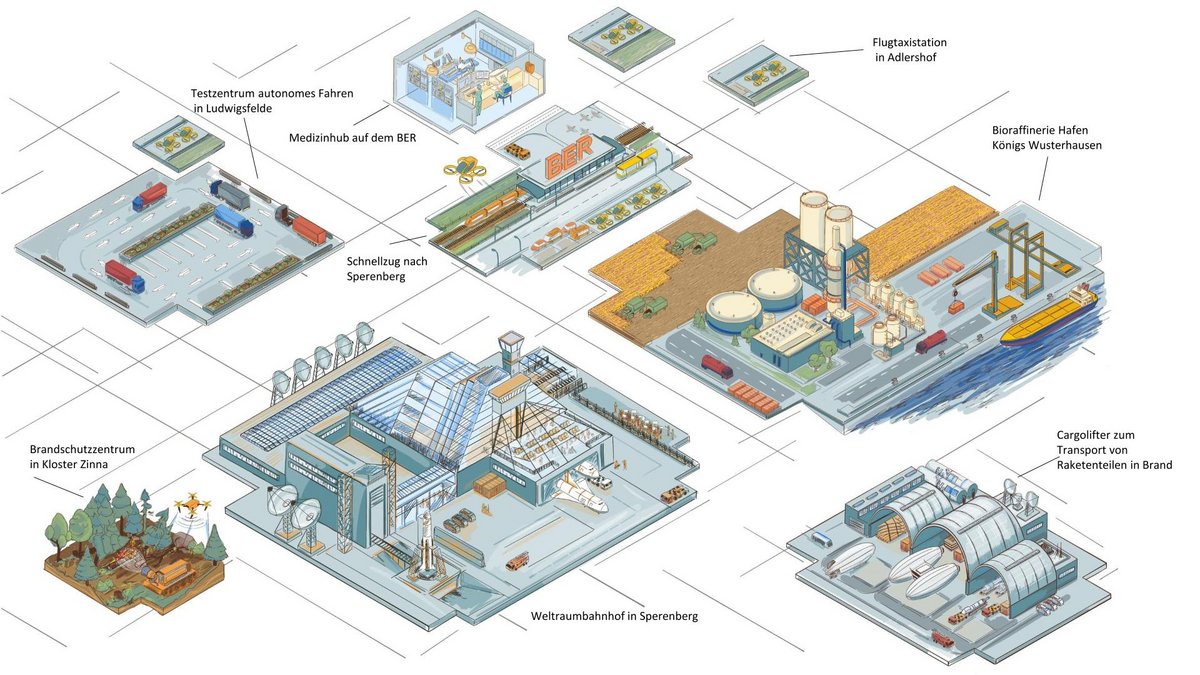Hyperloop and spaceport
We look at the news of the future. Agencies tick off two news items on June 30, 2035: +++ 1. The first Falcon 11 rocket takes off from the new spaceport in Sperenberg in the Teltow-Fläming district of Brandenburg. +++ 2. the company "LogLoop" carries out the first test run of the high-speed system in Sperenberg on the test route to the overseas port in Rostock. +++
Both systematically developed scenarios for the future of the Brandenburg airport region as a science and innovation location are an important interim result of the sub-project "Regional Foresight" within the framework of the Innovative University - Innovation Hub 13, the transfer project of BTU Cottbus-Senftenberg and TH Wildau.
The scenarios are intended to raise awareness of different development perspectives for the region and provide an opportunity to assess opportunities and risks at an early stage.
- Scenario 1 "Centrally controlled industrialization" uses elements of a spaceport, among other things,
- Scenario 2 "Decentralized specialization bottom-up", a terminal for so-called hyperloops (high-speed transport systems).
In a workshop on April 7, 2022, the identified perspectives were now discussed and concretized together with regional actors from municipalities, companies and the airport company BER. The results and thus the conclusion of the project will be prepared and presented to the public in the coming months.
With the scenario analysis, the project addresses the question of how the airport region can profile itself as a location for science and innovation by 2035, whether and which options are possible for specialization paths in the fields of business and science.
The exchange and transparency of different perspectives offers the opportunity to create a common understanding of the future, which in turn forms the prerequisite for coordinated action.
The future images developed, including the opportunities and risks associated with them, are intended to sensitize regional actors from the fields of science, business and local government to different futures and form a basis for deriving strategic courses of action for profiling the region.
Background
Since the beginning of 2021, the Innovation Hub 13 project team has developed the scenario analysis together with stakeholders from the region. Partial results were published in March 2022 under the title "Future of the Berlin-Brandenburg Airport Region as a Science and Innovation Location in 2035".
The scenario analysis was conceived from the outset as a participatory process in which regional stakeholders were involved in phases. Together with the Dialogforum Airport Berlin-Brandenburg and Complan Kommunalberatung GmbH, the concept was coordinated, the methodological procedure was defined, and an in-depth status quo analysis was conducted.
The Regional Foresight Team identified influencing factors and future projections in workshops with around 50 representatives from science, business and local authorities. Together, they identified nearly 200 influencing factors on which the selection of key factors was based. For these key factors, the project team generated 52 future projections, which led to the two scenarios "Centrally controlled industrialization" and "Decentralized specialization bottom-up". Following the graphically implemented scenarios, opportunities and risks could be derived, acting as a bridge for the development of action approaches and measures.
The"Innovation Hub 13 - fast track to transfer" is the interface between science, business and the public in the region along the A13.
The transfer project of the Technical University of Wildau and the Brandenburg University of Technology Cottbus-Senftenberg translates, mediates and supports the interdisciplinary exchange of knowledge, technologies and solutions in the fields of digital integration, lightweight construction and life sciences. It is one of the 29 selected winners of the federal-state funding initiative "Innovative University", equipped with funds from the Federal Ministry of Education and Research BMBF and the state of Brandenburg. For more information, visit www.innovative-hochschule.de.
Technical contact:
Dr. Frank Hartmann Research Group Innovation and Regional Research Wildau University of Applied Sciences E: frank.hartmann(at)th-wildau.de T: 03375 508 214
Contact
VP Wissens- und Technologietransfer und Struktur
T +49 (0) 355 69-4454
anne-kathrin.rensch(at)b-tu.de
Stabsstelle Kommunikation und Marketing
T +49 (0) 355 69-3126
susett.tanneberger(at)b-tu.de

